Biodegradable Packaging Market Size
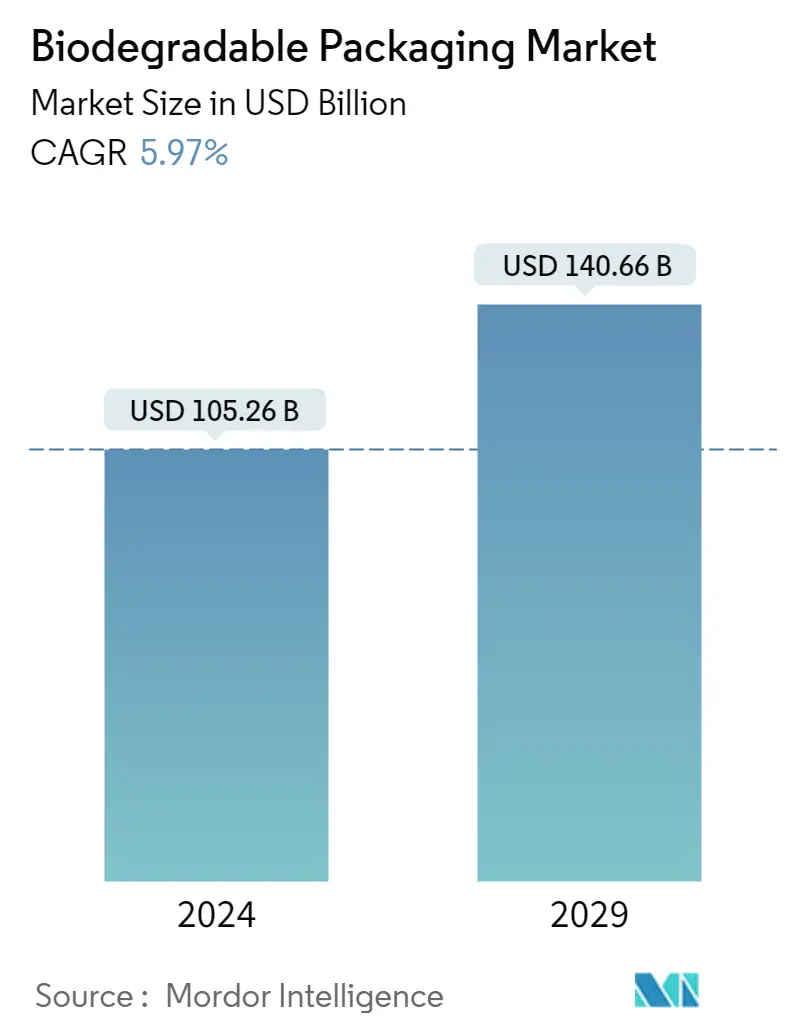
| Study Period | 2019 - 2029 |
| Market Size (2024) | USD 105.26 Billion |
| Market Size (2029) | USD 140.66 Billion |
| CAGR (2024 - 2029) | 5.97 % |
| Fastest Growing Market | Asia Pacific |
| Largest Market | Europe |
Major Players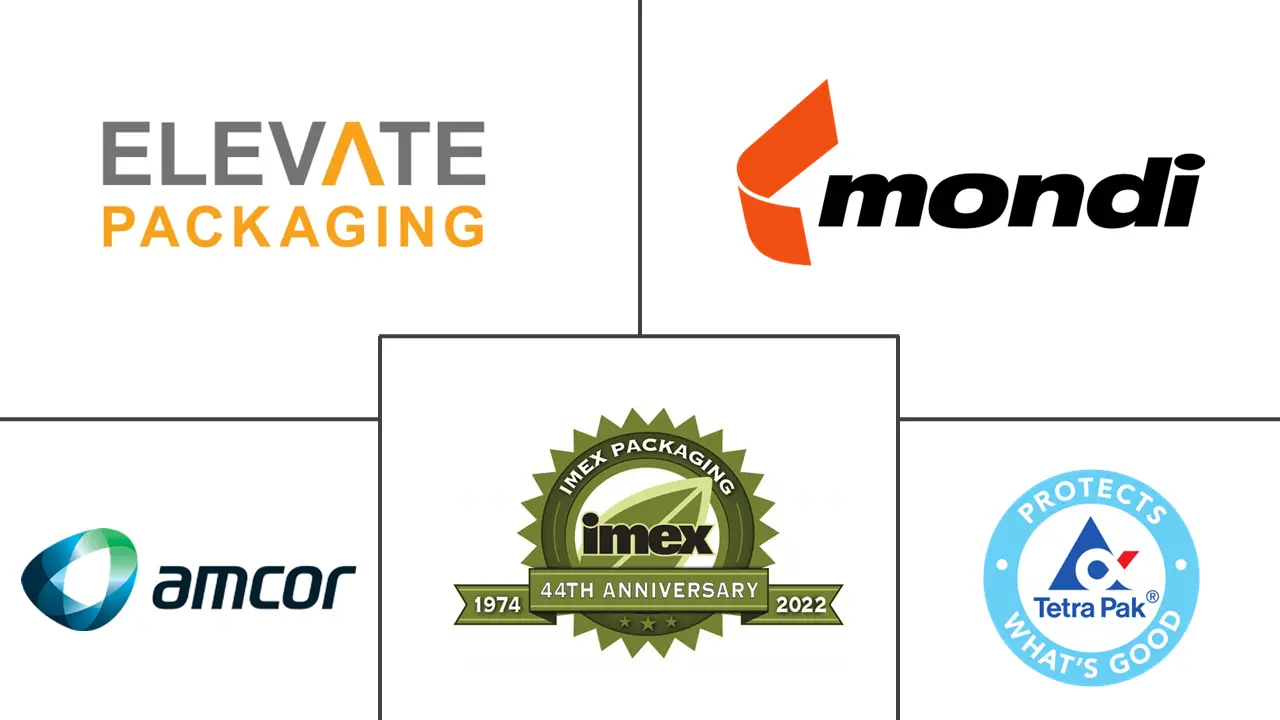
*Disclaimer: Major Players sorted in no particular order |
Need a report that reflects how COVID-19 has impacted this market and its growth?
Biodegradable Packaging Market Analysis
The Biodegradable Packaging Market size is estimated at USD 105.26 billion in 2024, and is expected to reach USD 140.66 billion by 2029, growing at a CAGR of 5.97% during the forecast period (2024-2029).
The demand for biodegradable packaging has increased over the past decade due to the growing awareness concerning environmental conservation, especially in the post-pandemic scenario. The growth of the market is being driven by increased consumer preference toward sustainable packaging materials and expanding demand for recyclable and biodegradable products across various end-user industries.
- Considering the growing demand, the manufacturers of bioplastics and other biodegradable materials are focusing on further expanding the production of these materials. For instance, according to European Bioplastics, the production capacity of bioplastics is expected to increase significantly from around 2.41 million tons in 2021 to approximately 7.59 million tons in 2026.
- With the increasing amount of packaging waste generated worldwide, governments across the globe are adapting to alternative sources, such as biodegradable packaging. The United States has only 4% of the world's population and generates 12% of global municipal solid waste (MSW). It is also stated that the United States produces about 106.2 kg of plastic waste per person per year. (Source: Environmental Protection Agency (EPA) of the United States).
- Various countries and organizations are trying to scrap the utilization of single-use plastic packaging, which is further creating a favorable market scenario for biodegradable packaging. In developing countries such as India, where packaging waste has become a major issue, state and central governments have begun to take steps to prohibit the use of single-use plastic.Several companies have started switching to eco-friendly alternatives. For instance, in India, a ban on select single-use plastic items came into effect on July 1, 2022. The law bans the manufacturing & stocking, import, distribution, sale, and use of identified single-use plastic items that have low utility and high littering potential.
- Similarly, to act against plastic pollution, the European Union put a ban on products such as single-use plastic plates, straws, cutlery, balloon sticks, cotton buds, etc. in July 2021. Furthermore, the European Union has placed restrictions on the use of cups, food and beverage containers made of expanded polystyrene, and all oxo-degradable plastic products.
Biodegradable Packaging Market Trends
This section covers the major market trends shaping the Biodegradable Packaging Market according to our research experts:
Personal/Homecare Packaging is Expected to be One of the Most Significant Applications
The trend toward using and seeking natural materials and additives for personal or cosmetic products has been rising as the adverse effects of synthetic materials on health and the environment became apparent. Currently, marketing trends are turning toward natural solutions for cosmetics, which promote a healthy lifestyle.
- According to CDF Corporation, the cosmetics and personal care industry embraces and contributes to the innovation of a sustainable packaging culture, pursuing packaging that reduces environmental impact by using natural materials that are reused, recycled, and reduced.
- Similarly, Pangea Organics has developed innovative packaging that combines creative design with a minimal ecological footprint. Made with WindPower 80, Pangea Organics' origami folding boxes aim for zero waste. This package is made of water-soluble PVOH plastic film. This is just one of the many attractive packaging designs that highlight the endless possibilities of sustainable packaging.
According to a survey conducted by Mondi Group in April 2022, the EU Plastics Strategy aims to transform how plastic products are designed, manufactured, used, and recycled in the EU. While this is important for the environment, it is also important for commercial success as consumers increasingly turn to brands that are taking smarter steps to tackle sustainability. Also, 64% of consumers in France, Italy, Poland, and Spain have switched to home brands that have adopted more sustainable packaging solutions in the past year alone.
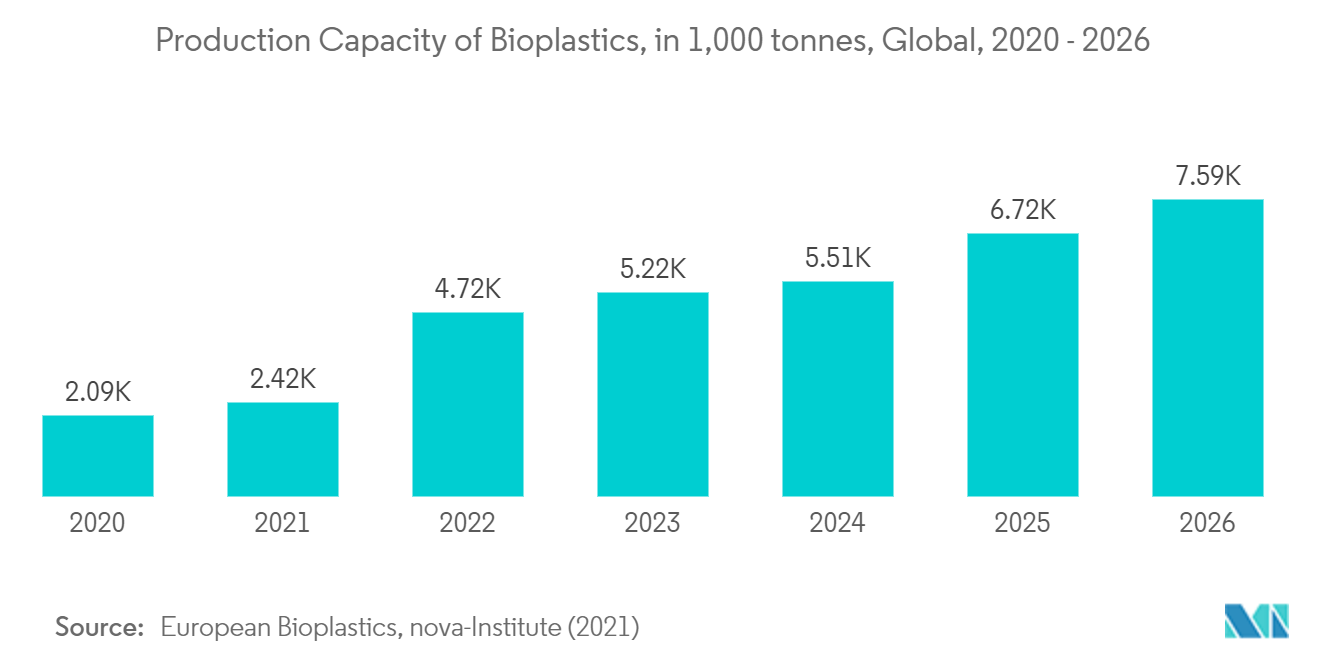
United Kingdom is Expected to Show Significant Growth Rate
- The United Kingdom (UK) is among the leading countries in Europe, wherein the demand for biodegradable packaging has been increasing. The higher awareness about the sustainability factors of packaging products, along with recent government initiatives, are creating a favorable market scenario for the growth of the studied market in the country.
- The ban on single-use plastics is among the primary factors that will directly impact the demand for biodegradable packaging products. For instance, in 2021, the UK government announced plans to ban single-use plastic cutlery, plates, and polystyrene cups in England to tackle plastic pollution.
- Several existing vendors, as well as startups operating in the packaging industry, are also taking the initiative to promote biodegradable packaging in the country. For instance, in June 2022, Magical Mushroom Company, a UK-based company, secured funding of EUR 3.4 million (USD 3.31 million) for its plant-based sustainable packaging.
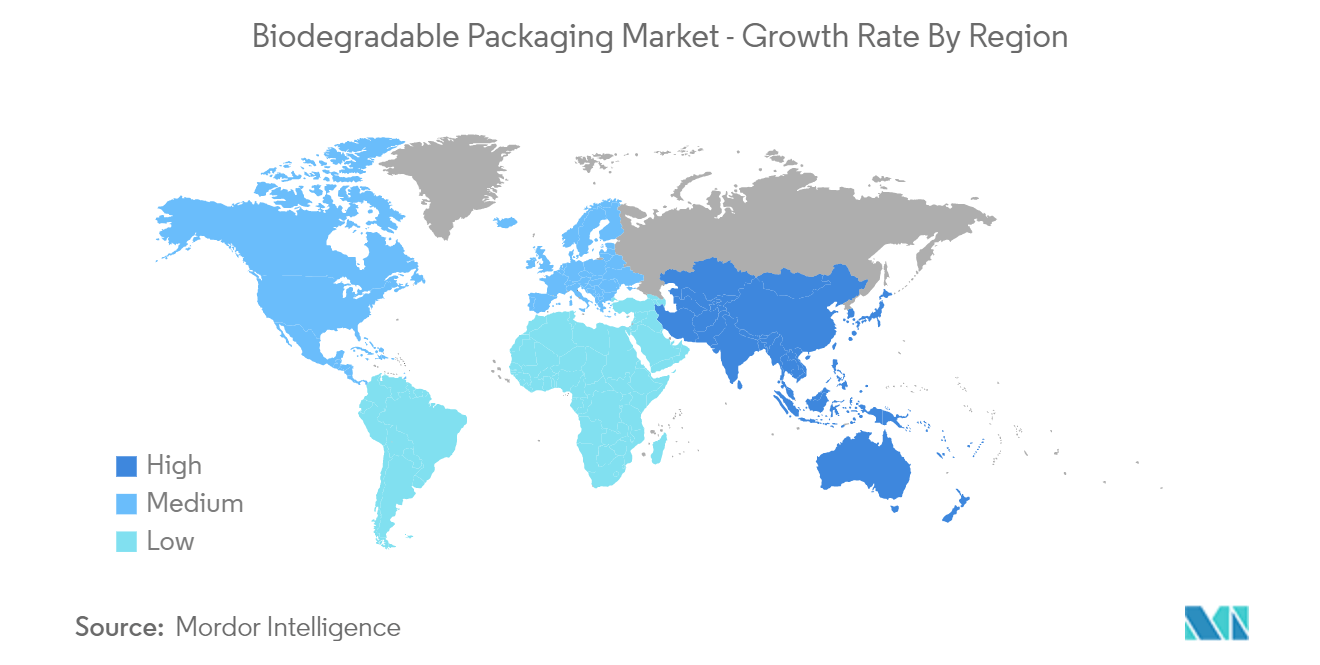
Biodegradable Packaging Industry Overview
The biodegradable packaging market is highly fragmented. The market studied comprises Amcor Limited, Sealed Air Corporation, Mondi Group PLC, and Tetra Pak International SA. Several regional firms in countries such as India are also trying to gain market share. Barriers to entry are low, resulting in the advent of smaller players and further increasing competitive rivalry.
In June 2021, Tetra Pak tied up with the FINISH Society, a well-known solid waste management NGO, to increase collection of used carton packages in Udaipur, Rajasthan, India. As part of the collaborative effort, FINISH Society will be working with the Municipal Corporation of Udaipur to recover used packs of juice or milk from the corporation's sorting centers, which will then be channeled to the nearest recycler. Tetra Pak and FINISH Society will also focus on raising awareness among the waste-picker community about the value of collecting used beverage cartons and selling them to a recycler.
Biodegradable Packaging Market Leaders
Mondi Group
Amcor PLC
Tetra Pak International SA
Elevate Packaging Inc.
Imex Packaging
*Disclaimer: Major Players sorted in no particular order
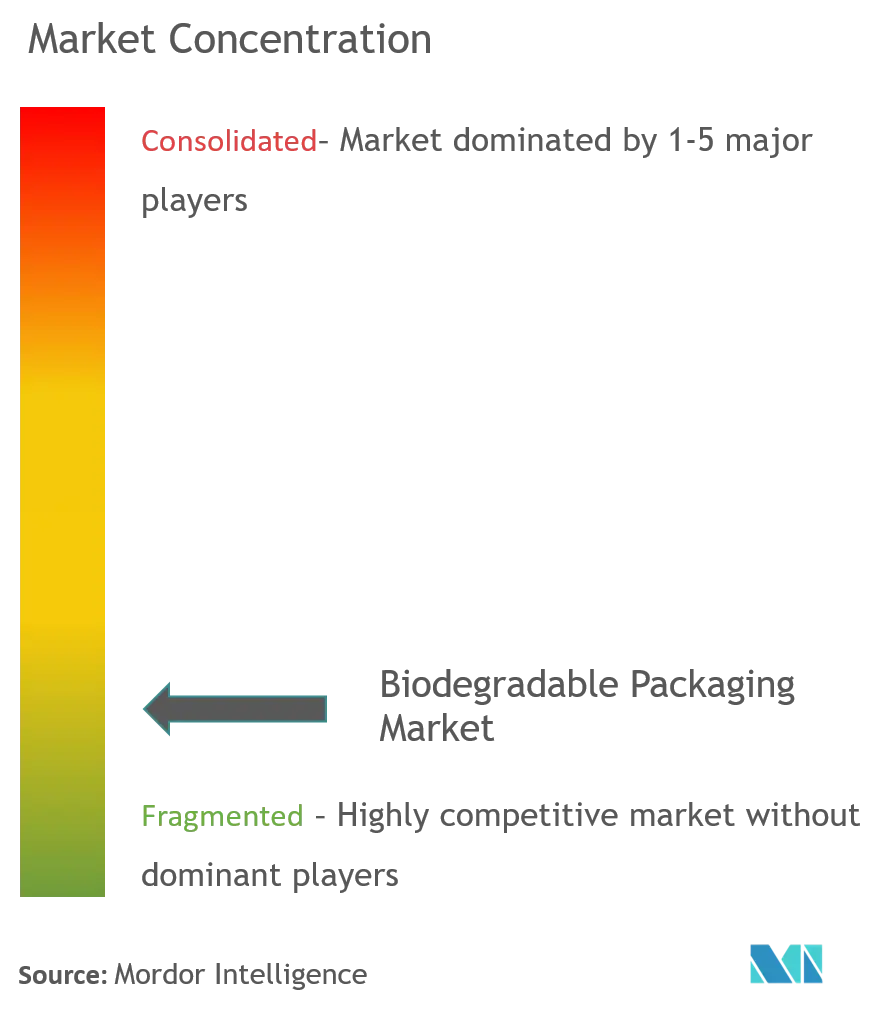
Biodegradable Packaging Market News
- May 2022: Amcor Rigid Packaging (ARP) announced the creation and launch of PowerPostTM. PowerPost technology produces nearly one-third lighter bottles with 30% less energy and 30% less carbon than most 20 oz. bottles by actively dislodging the vacuum in the container after filling.
- January 2022: Amcor PLC launched AmFiberTM, a new platform for paper-based packaging products. AmFiber's innovations aim to redefine the functionality of traditional paper packaging, offering a wider range of functional benefits to meet the changing needs of consumers. AmFiber's product is an innovative solution tailored to provide snacks and confectionery products to European customers with recyclable packaging that provides a high barrier to oxygen and moisture.
- January 2022: TIPA Corp., an Israeli-based company, nabbed a USD 70 million investment for developing compostable packaging solutions. According to the company, its eco-friendly films and laminates mimic the properties and functions of traditional plastic materials, including durability, barrier properties, and shelf stability.
Biodegradable Packaging Market Report - Table of Contents
1. INTRODUCTION
1.1 Study Assumptions & Market Definition
1.2 Scope of the Study
2. RESEARCH METHODOLOGY
3. EXECUTIVE SUMMARY
4. MARKET INSIGHTS
4.1 Market Overview
4.2 Industry Value Chain Analysis
4.3 Industry Attractiveness - Porter's Five Forces Analysis
4.3.1 Bargaining Power of Suppliers
4.3.2 Bargaining Power of Consumers
4.3.3 Threat of New Entrants
4.3.4 Threat of Substitute Products
4.3.5 Intensity of Competitive Rivalry
4.4 Technology Snapshot
4.5 Assessment of the Impact of COVID-19 on the Industry
5. MARKET DYNAMICS
5.1 Market Drivers
5.1.1 Increasing Demand For Sustainable Products By Consumers And Brands
5.1.2 Stringent Government Regulations
5.2 Market Restraints
5.2.1 Growing investments for Recyclable Packaging Solutions
5.2.2 Lack of Supply of Bio-plastics and Related Materials
6. MARKET SEGMENTATION
6.1 By Material Type
6.1.1 Plastic
6.1.1.1 Starch-Based Plastics
6.1.1.2 Cellulose-Based Plastics
6.1.1.3 Polylactic Acid (PLA)
6.1.1.4 Poly-3-Hydroxybutyrate (PHB)
6.1.1.5 Polyhydroxyalkanoates (PHA)
6.1.1.6 Other Plastics
6.1.2 Paper
6.1.2.1 Kraft Paper
6.1.2.2 Flexible Paper
6.1.2.3 Corrugated Fiberboard
6.1.2.4 Boxboard
6.2 By Application
6.2.1 Food Packaging
6.2.2 Beverage Packaging
6.2.3 Pharmaceutical Packaging
6.2.4 Personal/Homecare Packaging
6.2.5 Other Applications
6.3 Geography
6.3.1 North America
6.3.1.1 United States
6.3.1.2 Canada
6.3.2 Europe
6.3.2.1 United Kingdom
6.3.2.2 Germany
6.3.2.3 France
6.3.2.4 Rest of Europe
6.3.3 Asia Pacific
6.3.3.1 China
6.3.3.2 India
6.3.3.3 Japan
6.3.3.4 Rest of Asia Pacific
6.3.4 Rest of the World
6.3.4.1 Latin America
6.3.4.2 Middle East and Africa
7. COMPETITIVE LANDSCAPE
7.1 Company Profiles*
7.1.1 Tetra Pak International SA
7.1.2 Amcor PLC
7.1.3 Mondi Group
7.1.4 Imex Packaging
7.1.5 Elevate Packaging Inc.
7.1.6 Kruger Inc.
7.1.7 Biopak PTY LTD (Duni Group)
7.1.8 Smurfit Kappa Group PLC
7.1.9 Berkley International Packaging Limited
7.1.10 Greenpack Limited
7.1.11 International Paper Company
7.1.12 Ranpak Holding Corporation
8. INVESTMENT ANALYSIS
9. FUTURE OUTLOOK OF THE MARKET
10. ABOUT US
Biodegradable Packaging Industry Segmentation
Biodegradable refers to the ability of materials to break down and return to nature. In order for packaging products or materials to qualify as biodegradable, they must completely break down and decompose into natural elements within a short time after disposal, typically in a year or less.
The Biodegradable Packaging Market is segmented by Material Type (Plastics and Paper), Application (Food, Beverage, Pharmaceutical, Personal/Homecare), and Geography. The market sizes and values are provided in terms of value (in USD million) for all the above segments.
| By Material Type | ||||||||
| ||||||||
|
| By Application | |
| Food Packaging | |
| Beverage Packaging | |
| Pharmaceutical Packaging | |
| Personal/Homecare Packaging | |
| Other Applications |
| Geography | ||||||
| ||||||
| ||||||
| ||||||
|
Biodegradable Packaging Market Research FAQs
How big is the Biodegradable Packaging Market?
The Biodegradable Packaging Market size is expected to reach USD 105.26 billion in 2024 and grow at a CAGR of 5.97% to reach USD 140.66 billion by 2029.
What is the current Biodegradable Packaging Market size?
In 2024, the Biodegradable Packaging Market size is expected to reach USD 105.26 billion.
Who are the key players in Biodegradable Packaging Market?
Mondi Group , Amcor PLC, Tetra Pak International SA, Elevate Packaging Inc. and Imex Packaging are the major companies operating in the Biodegradable Packaging Market.
Which is the fastest growing region in Biodegradable Packaging Market?
Asia Pacific is estimated to grow at the highest CAGR over the forecast period (2024-2029).
Which region has the biggest share in Biodegradable Packaging Market?
In 2024, the Europe accounts for the largest market share in Biodegradable Packaging Market.
What years does this Biodegradable Packaging Market cover, and what was the market size in 2023?
In 2023, the Biodegradable Packaging Market size was estimated at USD 99.33 billion. The report covers the Biodegradable Packaging Market historical market size for years: 2019, 2020, 2021, 2022 and 2023. The report also forecasts the Biodegradable Packaging Market size for years: 2024, 2025, 2026, 2027, 2028 and 2029.
What challenges does the Biodegradable Packaging Market face?
The key challenges faced by the Biodegradable Packaging Market include higher costs of biodegradable materials compared to conventional packaging and limited recycling facilities.
What are the key drivers of the Biodegradable Packaging Market?
Key factors driving the Biodegradable Packaging Market are: a) Increasing environmental concerns b) Stringent government regulations on plastic use c) Growing consumer preference for sustainable packaging
Compostable Packaging Solutions Industry Report
The global biodegradable packaging market is witnessing significant growth, fueled by a surge in consumer preference for sustainable packaging and an increase in demand across various industries. This expansion is supported by government and non-government initiatives promoting eco-friendly packaging solutions, with a notable contribution from biodegradable packaging companies and suppliers. These entities are innovating and expanding their capacities, especially in biodegradable paper packaging, to meet the rising demand. The shift towards sustainable practices is driven by legislative changes, consumer awareness, and a desire to reduce environmental footprints, making biodegradable packaging a preferred choice. This trend is evident across industries, including food, beverage, personal care, and pharmaceuticals, as they move towards more sustainable packaging solutions. Compostable Packaging Solutions market analysis by Mordor Intelligence™ highlights this growth, offering insights into market share, size, and revenue growth rates. For a deeper understanding, a free report PDF download is available, providing a forecast outlook and historical overview of the market. As the market evolves, biodegradable packaging suppliers are crucial in the transition towards sustainability, reflecting changing consumer preferences and regulatory pressures.
